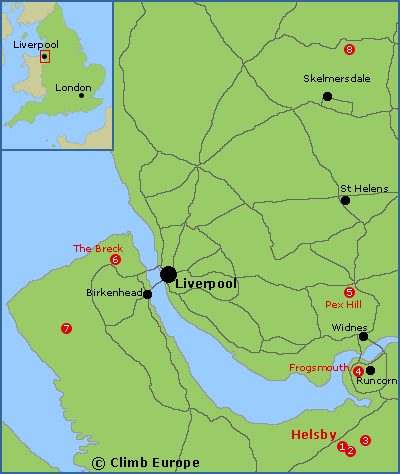Rock Climbing in Cheshire and Merseyside
Rock climbing in Cheshire and Merseyside is a combination of Trad climbing, bouldering and sport climbing on sandstone rock. The crags have short approaches that are easily accessible from the nearby cities of Manchester and Liverpool.
| No | Crag | Style of climbing | No of Routes | Grade Range | Aspect |
|---|---|---|---|---|---|
| 1 | Helsby | Trad climbing and bouldering | 266 | Mod to E8 and Vo to V6 | North/North-west |
| 2 | Harmers Wood | Bouldering | 55 | V0 to V7 | Various |
| 3 | Frodsham | Bouldering | 99 | Vo to V8 | West |
| 4 | Frogsmouth Quarry | Sport climbing | 53 | F4 to F8a | Various |
| 5 | Pex Hill | Bouldering and Trad climbing | 166 | Vo to V10 and Diff to E6 | Various |
| 6 | The Breck | Bouldering | 81 | V0 to V10 | Various |
| 7 | Irby Quarry | Trad climbing | 27 | Diff to E1 | Various |
| 8 | Parbold | Trad climbing | 43 | VDiff to E6 | West |
Map of the main Trad climbing, sport climbing and bouldering areas in Cheshire and Merseyside

This information has been extracted from the BMC Cheshire and Merseyside Sandstone guidebook that is available to buy from our shop. It describes all of the routes and bouldering at Helsby, Frogsmouth Quarry, Pex Hill, Harmers Wood, Frodsham, the Breck, Irby and Parbold.
1) Trad climbing and bouldering at Helsby
Helsby is by far the largest of Cheshire’s sandstone crags that stands tall and proud above the town of the same name. The crag is composed of fine-grained, natural sandstone that provides just about every style of climbing to be found. Routes can have blank, smeary slabs, fingery walls, flakes, brutal cracks, or jug laced roofs that demand good technique, confidence, or even a measured dose of boldness.
Helsby faces north to north-west, with much of the crag enjoying the afternoon sun, and is very popular on summer’s evenings. Helsby is a complex multiple tiered crag offering 190 Trad routes up to 20m long. As well as routes, there is some excellent bouldering with over 75 problems and traversing lines.
2) Bouldering at Harmers Wood
Harmers Wood provides a great bouldering venue in a beautiful little quarry on the hill behind Helsby. The sandstone rock at Harmers Wood is excellent with a great variety of features from striking aretes, perfect dihedrals, fingery pockets and blank walls – all above a mostly flat and soft floor. There are around 60 problems ranging from V0 to V7 including some excellent low-level traverses. The quarry is very sheltered and is at its best after a few dry days from spring through to the autumn. The trees can hold the damp for a day or so after rain.
3) Bouldering at Frodsham
The bouldering at Frodsham is all about fierce and juggy overhangs where a quick and confident approach is the key to success. The bouldering can feel a bit on the bold side at times, especially where the problems start becoming micro-routes that can be up to 8m high. Spotters and plenty of mats are highly recommended. Due to the thick tree cover during the summer the best time to boulder at Frodsham is in the spring and autumn.
4) Sport climbing at Frogsmouth Quarry
Frogsmouth Quarry is at the top of the hill in Runcorn, located in a small country park that offers bolted routes up to 20m high. The style of climbing found at Frogsmouth is high quality wall routes that are well bolted. The various crag faces catch the afternoon and evening sun, and the best time to climb at Frogsmouth Quarry is from the spring through to the autumn.
5) Bouldering at Pex Hill
Pex Hill is a disused sandstone quarry, located on the outskirts of Widnes. Pex offers great quality rock that contains over 160 climbs, mainly from boulder problems and micro-routes to walls with Trad routes up to 12m long. The style of climbing found at Pex requires neat footwork and pulling on fine crimps, with many of the mirco-routes soled – so bring plenty of mats. In addition to the routes there are many fine traverses, often close to the ground, that make Pex an ideal training venue, or suitable if you are on your own. The crag is sheltered and the walls face all directions so the sun or shade can generally be found.
6) Bouldering at the Breck
The Breck is a long disused sandstone quarry, located near Wallasey in the Wirral. The bouldering at the Breck has a reputation requiring strong fingers and good technique. The holds typically comprise of sharp crimps and a fantastic array of pockets of all sizes that produce brilliantly technical and often sequency face climbing. Nearly all the landings are on flat grass and can be easily protected with spotters and mats, though some of the highest routes are often done on a top rope. The best time to boulder at the Breck is in winter when the trees lose their leaves.
7) Trad climbing at Irby
Again located in the Wirral, the Trad climbing at Irby offers 27 routes that are mostly between S and VS. However there is little in the way of protection, so the routes are usually soloed or top roped. The sandstone rock is clean and quick drying after rain, especially the south facing wall. It is sheltered from the wind and is often in condition when many of the other local crags aren’t.
8) Trad climbing at Parbold
Parbold is the furthest north of the Merseyside crags, located to the north of Skelmersdale. The Trad climbing at Parbold is on fine grained quarried gritstone that is at its best on a fine spring day before the leaf cover becomes too heavy.